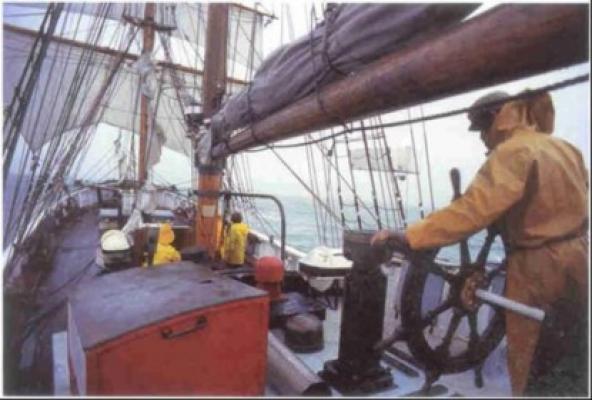SELF-STEERING UNDER SAIL. Peter Foerthmann
Читать онлайн.| Название | SELF-STEERING UNDER SAIL |
|---|---|
| Автор произведения | Peter Foerthmann |
| Жанр | Языкознание |
| Серия | |
| Издательство | Языкознание |
| Год выпуска | 0 |
| isbn | 9783844256406 |
The following systems are available:
Navico WP 300 CX Wheel autopilot
The AUTOHELM ST 800 Tiller autopilot
Inboard Autopilots
Inboard autopilots use push rod or hydraulic systems with powerful motors which are connected to the rudder post or quadrant and turn the main rudder directly. It is also possible to replace the mechanical linkage and shaft with a hydraulic system in which a hydraulic pump provides oil pressure to drive a hydraulic cylinder which in turn moves the main rudder. This type of system is suitable for larger boats. Vessels over 60 feet in length with sizeable hydraulic rudder arrangements use constantly running pumps controlled by solenoid valves for the autopilot.
The Three Modules of an Inboard Autopilot
Control unit
The control unit is used to call up all the functions of the autopilot and any other modules linked via the data bus. It is usually possible to mount additional control units wherever they are needed, so the operator is not restricted to the main cockpit. A hand-held remote control unit provides even more freedom to move about the deck. Joysticks offering direct control of the autopilot drive unit are also available.
Central processing unit
The central processing unit consists of:
a. Course computer
The course computer, installed below deck, is responsible for processing all commands and signals, for calculating the rudder movements necessary for course correction and for actuating the drive unit.
b. Fluxgate compass
An autopilot can only steer a good course if the steering impulse from the compass is accurate and clear. Fluxgate sensors, which supply the course computer with precise course data, are used by all manufacturers. Steering performance in testing conditions can be optimised by installing special additional fluxgate systems. Autohelm uses a ‘GyroPlus’ transducer while Robertson has a novel electronic compass, a modification of the conventional magnetic compass, which promises to help the autopilot steer more smoothly.
c. Rudder position indicator
The rudder position transducer is arranged on the rudder and informs the course computer of the position of the rudder.
d. Windvane (optional)
e. Peripherals
Signals from additional navigation equipment such as Decca, GPS, Loran, radar, log and depth sounder can also be fed to the course computer for consideration with regard to steering movements.
Drive unit
There are four alternatives.
a. Linear drive unit:
An electric motor operates the push rod mechanically via a transmission.
These drives are similar in principle to cockpit autopilots, but are considerably more powerful. Depending on the particular use and the size of the system it may be advisable to use metal for the transmission components since plastic is not always able to withstand the heavy loading associated with extended operation. Autohelm offers the ‘Grand Prix’ package as an upgrade for its linear drive units and Robertson uses metal transmission components as standard.
b. Linear/hydraulic drive unit:
The push rod is operated by a hydraulic pump. Linear/hydraulic drives appear on large yachts with particularly high rudder forces. The drives may be supplied either by separately installed hydraulic pumps (Autohelm, VDO) or by pumps directly incorporated into the push rod system (Brookes and Gatehouse, Robertson). Robertson also offers ‘dual drives’, in which two linear drives double the force applied.
c. Hydraulic drive units:
These electromechanical hydraulic pumps tap directly into the existing wheel steering hydraulic system. A constantly running pump may be used to supply the force required to steer boats of 25 tonnes or more.
d. Chain drive unit:
An electric motor operates the main rudder via a chain. Chain drives are preferred where space is limited or where the rod-operated or geared wheel steering system on an older boat precludes the use of other drive units.
Integrated Systems
Until a few years ago it was generally the case that boat owners acquired their instruments one by one. Depth sounder, radar, compass, wind instrument, Decca, GPS, plotter, boat speed indicator and autopilot might easily be individually installed stand-alone units from several different manufacturers.
The situation today is very different, with a few major suppliers offering complete systems from which the sailor can choose as few or as many instruments as desired. Essential to this advance was the development of a specialised data protocol (data bus): functions such as the steering performance of an autopilot module can now be optimised in more demanding systems by connecting a dedicated course computer. An autopilot steering a boat between two waypoints obtained from a GPS interface can thus correct for cross-track error caused by currents running perpendicular to the boat’s course.
The changing role of companies within the industry from instrument manufacturers to system suppliers explains the current extreme concentration of the market on just three major players.
Autopilots may be divided into three groups:
a. Stand-alone systems which operate solely on the basis of a windvane or compass signal (e.g. AUTOHELM 800),
b. Systems which are linked to other modules via a data bus (e.g. SEATALK from Autohelm, NETWORK from B&G),
c. Intelligent systems in which the data of the individual modules is optimised by a relatively powerful computer (e.g. ROBERTSON AP 300, AUTOHELM 6000/7000, B&G HYDRA/HERCULES).
Today most autopilots operate as one module within a complex system. NMEA (National Marine Electronics Association) interfaces offer the prospect of expanding such a system to include instruments from other manufacturers. In reality, however, the claim that instruments from different system suppliers can communicate with each other using the same interfaces has proven to be something of a fallacy. There are, as many sailors have already discovered to their cost, several standards
